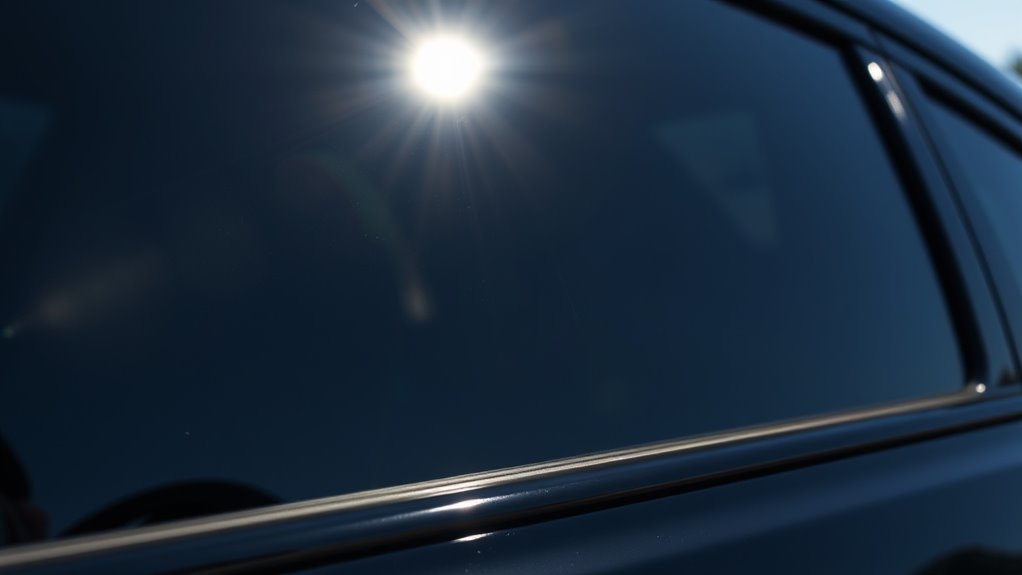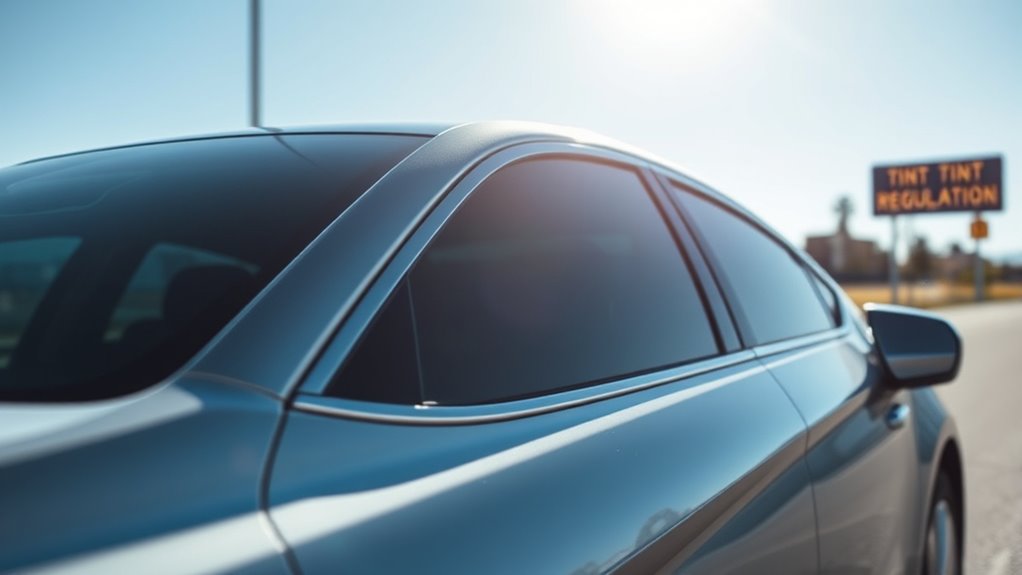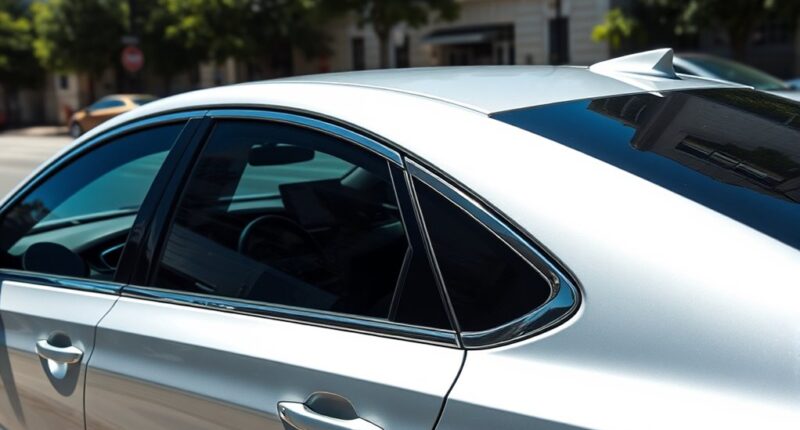Window tinting laws differ by state, setting rules on how dark or reflective your tint can be. Most states require at least 70% VLT for front side windows and restrict reflectivity. Penalties for violations range from fines to license suspensions, and enforcement includes tint meters and visual checks. Vehicle types may have specific limits, so knowing your local laws helps avoid fines and permits safe driving. Continue exploring to understand how to stay compliant and protect yourself legally.
Key Takeaways
- Window tinting laws vary by state, including specific VLT percentages and reflectivity restrictions for different vehicle types.
- Most states require at least 70% VLT for front side windows, with stricter limits for windshields and rear windows.
- Violating tint regulations can result in fines up to $1,000, vehicle registration suspension, or removal orders.
- Law enforcement uses tint meters and visual checks during traffic stops to ensure compliance.
- Medical exemptions may allow darker tinting if proper documentation is provided and verified.
State-Specific Window Tinting Regulations

Understanding state-specific window tinting regulations is essential before you get your vehicle tinted, as rules vary widely across the U.S. You need to know what’s allowed in your state to avoid fines or the need to remove tint later. For example, Illinois permits non-reflective tint only on the top 6 inches of the windshield, while Ohio allows up to 70% VLT across the entire windshield. North Dakota requires at least 70% VLT on the windshield, and Kentucky restricts tint to above the manufacturer-defined AS-1 line. For side windows, Illinois and North Carolina mandate a minimum of 35% VLT, with Kentucky limiting darkness to 35% maximum. Each state also has specific rear window VLT limits, reflectivity rules, and mirror requirements, so check your local laws carefully before tinting.
Legal Penalties for Non-Compliance

What are the consequences if you ignore your state’s window tinting laws? You risk hefty fines—up to $1,000 for a first offense in Texas—and escalating penalties for repeat violations, including potential jail time. Fines can range from $20 to $275, depending on your jurisdiction and the severity of the violation. You might also receive citations and points on your driving record, which can lead to higher insurance premiums and inconvenience. Courts may order you to remove illegal tint, and your vehicle’s registration could be suspended, adding to costs. Law enforcement can detect illegal tint during traffic stops, leading to legal proceedings and increased expenses. In extreme cases, you could face driving restrictions until you comply, making non-compliance costly and inconvenient. Additionally, understanding industry trends can help you stay informed about changes in regulations and best practices. Staying updated on legal limits ensures you remain compliant and avoid penalties. Being aware of enforcement techniques can also help you understand how authorities identify violations more effectively. Moreover, advancements in technology are making it easier for law enforcement to detect illegal tint with specialized tools.
Visibility Standards and Safety Requirements

Ignoring window tinting laws can not only lead to legal penalties but also compromise your safety on the road. Most states require at least 70% VLT for front side windows to ensure clear visibility. The federal guidance aligns, emphasizing light transmittance for safety. State variations exist: Hawaii allows only 35%, while California mandates 70%. Law enforcement uses VLT meters and visual checks to verify compliance. Proper visibility reduces accidents, especially in low-light conditions. Consider this table:
| Aspect | Requirement/Guidelines |
|---|---|
| Front Side Windows | Minimum 70% VLT in most states |
| Windshield Tinting | Top 4-6 inches can be tinted |
| Rear Windows | Often darker allowances, vary by state |
| Reflectivity Limits | Max 25% luminous reflectance |
| Compliance Verification | VLT meters and certification labels |
Additionally, content ownership rights are a contentious issue between AI giants and creators, emphasizing the importance of understanding legal boundaries in various industries. Ensuring compliance with these regulations not only avoids penalties but also enhances overall road safety for all drivers. Proper visibility reduces the risk of accidents and promotes safer driving conditions. Clear visibility isn’t just legal—it’s essential for safe driving. Staying informed about regulatory updates helps drivers maintain compliance and adapt to new standards as they develop. Being aware of electric bike performance standards can also influence the type of vehicles and accessories used on the road.
Automotive Window Tint Percentages and Limits

Automotive window tint percentages specify how much light can pass through your vehicle’s windows, with lower percentages indicating darker tints. For example, a 5% tint (limo tint) blocks 95% of light, offering maximum privacy, while 90% tint is nearly clear. Front windows generally require higher VLT% than rear windows, often around 50%, allowing more light in. The combined VLT, calculated by multiplying existing glass VLT by tint film VLT, determines overall darkness—so layering darker films can create illegal low VLTs. Many states permit front side windows between 50-70% VLT, while rear windows often allow darker tints, like 20-35%. Windshield laws vary, with some states restricting tint to the top strip. Enforcers use tint meters to verify compliance, and penalties can include fines or removal. Understanding automotive window tint laws is essential for legal compliance and safety. Additionally, visual perception can be affected by the darkness of window tints, which is important to consider for safe driving in various lighting conditions. Regular appliance testing can help ensure that your vehicle’s electrical systems are functioning safely, especially when installing new tinting films or other modifications.
Vehicle Types and Their Unique Tint Laws

Vehicle types influence tint laws considerably, as different regulations apply depending on the vehicle’s classification and features. In Texas, tint rules are uniform across all vehicle types, including cars, trucks, SUVs, and vans. California’s laws are mostly similar for passenger vehicles but may differ for vans and trucks. Some states, like Alaska, permit up to 70% VLT on front side windows, while Alabama restricts all windows to 32%. Arizona allows darker tints on back windows if dual side mirrors are installed. Vehicle features, such as dual mirrors or exterior elements, also impact tint regulations. Understanding these differences guarantees you stay compliant based on your vehicle’s type and specific features, especially considering vehicle-specific tint laws that can vary widely. Additionally, specialized vehicle regulations often specify tint limits for emergency, commercial, or other specialized vehicle categories to ensure safety and compliance. Recognizing the importance of compliance helps prevent legal issues and potential fines related to improper tinting, particularly since different state laws may have unique requirements for various vehicle types and features.
Ensuring Compliance and Navigating Enforcement

To make certain you stay compliant with tint laws, understanding the specific requirements and enforcement practices in your state is vital. In New Jersey, this means knowing that a medical exemption certification is required for front window tints, with valid certificates lasting 48 months. You must display your medical certificate during traffic stops and ensure your vehicle has the proper installer labeling. The law enforces a minimum VLT of 70% for factory-applied front window tints, except for exempt vehicles. Police can test tints using authorized protocols, and violations can result in fines up to $100, with mandatory removal orders for illegal tint. Presenting valid medical proof can dismiss violations in court, and law enforcement has authority for exemption verification during registration checks. Additionally, understanding wave and wind influences can help determine the best tint options that comply with legal standards while maximizing comfort and safety. Knowing the regulations and enforcement, including how tint levels are tested, can help vehicle owners avoid penalties and ensure their tints remain within legal limits. Regularly monitoring visual cues such as tint reflections and driver visibility can also aid in maintaining compliance and safety while on the road. Being aware of auditory alerts and signals used in vehicle systems can further assist in detecting tint violations early and avoiding penalties.
Frequently Asked Questions
Can I Get a Tint Exemption for Medical Reasons?
You can get a tint exemption for medical reasons if your doctor certifies that you have conditions like photophobia or skin sensitivities. You’ll need a written diagnosis and recommendation from a licensed physician or optometrist. Then, you submit the proper application and supporting documents to your state’s DMV or relevant authority. Make sure to follow your state’s specific process and guidelines to guarantee your exemption is approved legally.
Are There Different Tint Laws for Commercial vs. Passenger Vehicles?
Your query questions whether commercial and passenger vehicles face different tint laws. In Virginia, you’ll find uniformity—rules are consistent across all vehicles, whether passenger or commercial. You must follow the same minimum visible light transmission (VLT) standards, with no special exceptions for commercial vehicles beyond typical requirements. So, whether you’re driving a truck or a sedan, the tint rules stay steady, simplifying your safety and style decisions.
How Often Do Window Tint Laws Get Updated or Changed?
You’re wondering how often window tint laws change. These laws are updated sporadically, usually when new safety standards, technology, or safety concerns emerge. Updates happen through legislation or regulatory changes by state departments. Factors like traffic safety research, technological advances, public demand, or economic influences can prompt updates. These changes often involve public hearings and legislative approval, so the frequency varies, but they generally don’t occur annually.
Do Tint Laws Apply to All States Equally?
Did you know that window tint laws vary widely across the U.S., with some states allowing as little as 5% VLT and others up to 70%? You might think laws are consistent nationwide, but they aren’t. Each state sets its own rules, meaning what’s legal in one place could be illegal next door. So, you need to check your state’s specific regulations before tinting your windows.
Is Aftermarket Tinting More Likely to Be Illegal Than Factory Tint?
When considering if aftermarket tinting is more likely to be illegal than factory tint, remember that aftermarket films aren’t universally compliant. You often have to verify they meet your state’s VLT limits, and non-compliance can lead to fines. Factory tinting, however, is tested and approved by manufacturers, making it less likely to be illegal. So, if you install aftermarket tint, you need to be extra cautious about adhering to local laws.
Conclusion
Think of window tint laws as the guardrails guiding your journey. They keep you safe from unseen dangers and help you stay on the right path. Ignoring these limits is like venturing off-road without guidance—you’re risking more than just a ticket. By understanding and respecting your state’s regulations, you ensure your ride remains a smooth, secure ride through life’s twists and turns. Stay compliant, stay safe, and let your journey shine brightly within the boundaries of the law.










